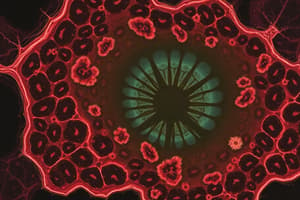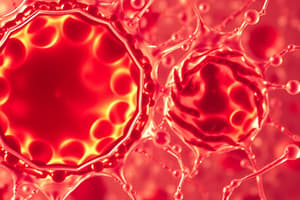Podcast
Questions and Answers
What is cytology?
What is cytology?
The study of cell structure.
How many types of cells are there in the human body?
How many types of cells are there in the human body?
About 200 types.
Cell theory states that all living things are made of cells.
Cell theory states that all living things are made of cells.
True (A)
What are the two main types of cells?
What are the two main types of cells?
Which of the following is a characteristic of eukaryotic cells?
Which of the following is a characteristic of eukaryotic cells?
Which of the following structures do plant cells have that animal cells do not?
Which of the following structures do plant cells have that animal cells do not?
What are the main components of the cell membrane?
What are the main components of the cell membrane?
The process of cell division for asexual reproduction is called ________.
The process of cell division for asexual reproduction is called ________.
Match the following cell junctions with their descriptions:
Match the following cell junctions with their descriptions:
What type of transport requires energy?
What type of transport requires energy?
Flashcards are hidden until you start studying
Study Notes
Cytology
- The study of cell structure
- There are about 200 types of cells in the human body
- Each cell type has a specialized function within the body
- Electron microscopes are used to study the fine structure of cells
Cell Theory
- Cells are the smallest independent living entities capable of independent life (e.g., flagellates, amebas)
- All living things are made of cells
- Cells originate from pre-existing cells
Basic Cell Properties
- Metabolism and Energy Generation: Cells undergo essential chemical processes to sustain life
- Reproduction by Cell Division:
- Mitosis: Asexual reproduction where cells divide to form new cells
- Meiosis: Occurs in testes and ovaries as part of sexual reproduction
- Sensitivity and Response to Stimulation: Cells react to stimuli within their environment
Cell Number and Size
- The human body is made up of approximately 75 trillion cells
- The body contains around 200 different cell types.
- Cell sizes vary within the body, ranging from 5 μm (e.g., small lymphocytes) to 150 μm (e.g., the female ovum)
- Cell number is influenced by body size
- Cell size is influenced by the cell's function
Cell Shape
- The shapes of human cells vary greatly (shape is influenced by function):
- Ova are round
- Neurons have processes
- Muscle cells have fibrils
- White blood cells (WBCs) exhibit changeable shapes
- Animal cells are mostly round and irregular in shape
- Plant cells have fixed, rectangular shapes due to their cell walls
Types of Cells
- Eukaryotic Cells:
- Have a defined nucleus enclosed by a nuclear membrane
- Contain membrane-bound organelles (e.g., Golgi apparatus, mitochondria, endoplasmic reticulum)
- Include human, animal, and plant cells
- Prokaryotic Cells:
- Lack a defined nucleus (no nuclear membrane)
- Possess a nucleoid (region of DNA concentration)
- Lack membrane-bound organelles (e.g., endoplasmic reticulum, Golgi apparatus)
- Include bacteria (bacterium)
Animal cells vs Plant cells
- Plant Cells contain
- Cell wall: Provides structural support
- Chloroplasts: Sites of photosynthesis
- Plastids: Involved in storage and pigment production
- Large central vacuole: Stores water and other substances
- Animal cells do not have these structures.
Cell Membrane (Plasma Membrane or Plasmalemma)
- Forms the outer boundary of all cells
- Consists of a lipid bilayer
- Composed of:
- Lipids: About 35% (phospholipids and cholesterol)
- Proteins: About 60%
- Carbohydrates: About 5%
Molecular Structure of Cell Membrane
- Phospholipids:
- Hydrophilic heads face outwards
- Hydrophobic fatty acid tails are in the middle
- Proteins:
- Intrinsic proteins (integral) or transmembrane proteins: Embedded within the cell membrane
- Extrinsic proteins (peripheral): Located on the outer and inner surfaces, often involved in transport and as receptors
- Carbohydrates: Form a glycocalyx coat on the outer surface of the cell membrane
Cell Membrane Specializations (Projections)
- Microvilli: Finger-like projections that increase surface area for absorption, found in the intestines
- Cilia: Motile processes extending from the free surface of cells, found in the respiratory system and oviduct
- Stereocilia: Non-true cilia, but long microvilli, found in the epididymis, involved in absorption
- Flagella: Cilia-like structures, found in the tail of mature sperm, facilitating sperm movement
Types of Cell Junctions
- Cell junctions connect cells to neighboring cells
- Found in epithelial cells, smooth muscle cells, and cardiac muscle cells
- Types:
- Tight junctions: Seal the intercellular space, preventing leakage
- Adherens junctions: Anchor cells together, providing structural support
- Desmosomes: Strong junctions that hold cells together, ensuring structural integrity
- Gap junctions: Allow communication between cells, facilitating the passage of small molecules
- Hemidesmosomes: Attach cells to the basal lamina (basement membrane)
Main Functions of Cell Membrane
- Transfer of Nutrients and Metabolites:
- Active Transport: Requires energy to move substances across the membrane against their concentration gradient
- Passive Transport: Does not require energy, movement is driven by concentration gradients
- Osmosis: Movement of water across a selectively permeable membrane
- Hypertonic: Higher solute concentration outside the cell, causing water to leave the cell
- Isotonic: Equal solute concentration inside and outside the cell, water movement is balanced
- Hypotonic: Lower solute concentration outside the cell, water enters the cell
- Osmosis: Movement of water across a selectively permeable membrane
- Phagocytosis: Intake of solid material by the cell
- Pinocytosis: Intake of liquid material by the cell
- Exocytosis: Discharge of materials outside the cell
- Endocytosis: Intake of materials inside the cell
- Cell Signaling and Communication: The cell membrane plays a crucial role in receiving signals from the environment and initiating intracellular responses.
- Structural Support: Provides a barrier that helps maintain the cell's shape and integrity.
Studying That Suits You
Use AI to generate personalized quizzes and flashcards to suit your learning preferences.




